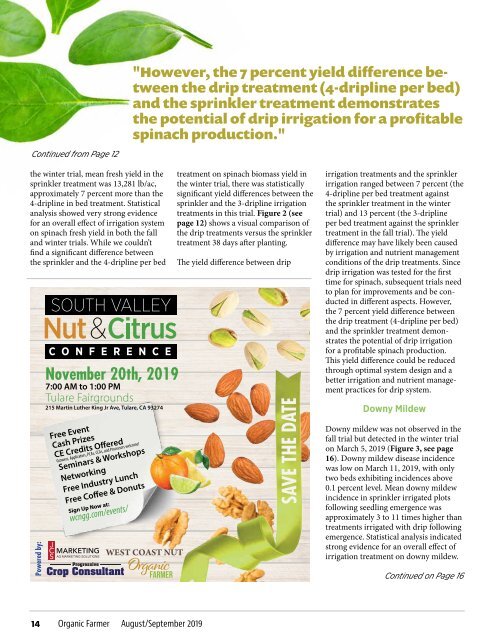Organic Farmer Aug/Sept 2019
- No tags were found...
You also want an ePaper? Increase the reach of your titles
YUMPU automatically turns print PDFs into web optimized ePapers that Google loves.
"However, the 7 percent yield difference between<br />
the drip treatment (4-dripline per bed)<br />
and the sprinkler treatment demonstrates<br />
the potential of drip irrigation for a profitable<br />
spinach production."<br />
Continued from Page 12<br />
the winter trial, mean fresh yield in the<br />
sprinkler treatment was 13,281 lb/ac,<br />
approximately 7 percent more than the<br />
4-dripline in bed treatment. Statistical<br />
analysis showed very strong evidence<br />
for an overall effect of irrigation system<br />
on spinach fresh yield in both the fall<br />
and winter trials. While we couldn’t<br />
find a significant difference between<br />
the sprinkler and the 4-dripline per bed<br />
November 20th, <strong>2019</strong><br />
7:00 AM to 1:00 PM<br />
Tulare Fairgrounds<br />
215 Martin Luther King Jr Ave, Tulare, CA 93274<br />
treatment on spinach biomass yield in<br />
the winter trial, there was statistically<br />
significant yield differences between the<br />
sprinkler and the 3-dripline irrigation<br />
treatments in this trial. Figure 2 (see<br />
page 12) shows a visual comparison of<br />
the drip treatments versus the sprinkler<br />
treatment 38 days after planting.<br />
The yield difference between drip<br />
irrigation treatments and the sprinkler<br />
irrigation ranged between 7 percent (the<br />
4-dripline per bed treatment against<br />
the sprinkler treatment in the winter<br />
trial) and 13 percent (the 3-dripline<br />
per bed treatment against the sprinkler<br />
treatment in the fall trial). The yield<br />
difference may have likely been caused<br />
by irrigation and nutrient management<br />
conditions of the drip treatments. Since<br />
drip irrigation was tested for the first<br />
time for spinach, subsequent trials need<br />
to plan for improvements and be conducted<br />
in different aspects. However,<br />
the 7 percent yield difference between<br />
the drip treatment (4-dripline per bed)<br />
and the sprinkler treatment demonstrates<br />
the potential of drip irrigation<br />
for a profitable spinach production.<br />
This yield difference could be reduced<br />
through optimal system design and a<br />
better irrigation and nutrient management<br />
practices for drip system.<br />
Downy Mildew<br />
SAVE THE DATE<br />
Powered by:<br />
Free Event<br />
Cash Prizes<br />
CE Credits Offered<br />
Growers, Applicators, PCAs, CCAs, and Processors welcome!<br />
Seminars & Workshops<br />
Networking<br />
Free Industry Lunch<br />
Free Coffee & Donuts<br />
Sign Up Now at:<br />
wcngg.com/events/<br />
Downy mildew was not observed in the<br />
fall trial but detected in the winter trial<br />
on March 5, <strong>2019</strong> (Figure 3, see page<br />
16). Downy mildew disease incidence<br />
was low on March 11, <strong>2019</strong>, with only<br />
two beds exhibiting incidences above<br />
0.1 percent level. Mean downy mildew<br />
incidence in sprinkler irrigated plots<br />
following seedling emergence was<br />
approximately 3 to 11 times higher than<br />
treatments irrigated with drip following<br />
emergence. Statistical analysis indicated<br />
strong evidence for an overall effect of<br />
irrigation treatment on downy mildew.<br />
Continued on Page 16<br />
14<br />
<strong>Organic</strong> <strong>Farmer</strong> <strong>Aug</strong>ust/<strong>Sept</strong>ember <strong>2019</strong>


















